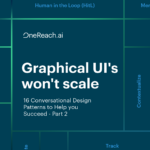
post
September 22, 2021
No-Code = Fewer Barriers
What’s really happening when people employ these tools and processes: software creation.
Fifty years ago, if you worked on a computer, you almost certainly worked in something called “the computer department.” These days, the notion of a computer department is so antiquated that it’s foreign. Nearly everyone works on a computer. Now apply that same dynamic to software development. Currently, most companies use third party software solutions, consulting vendors, or have an internal software development department that builds/codes the software they need. Now imagine a world where anyone can build software solutions (in much the same way everyone can now use a computer).
You won’t have to wait 50 years for this world to materialize. This seismic shift is upon us. We’re well on our way to the “development department” being a thing of the past—gone with the time and energy that companies so often pour into development cycles. Enabling your company to program hyper-automation of business processes, tasks, and communications without writing code eliminates the need for a traditional development cycle and is a key factor that accelerates growth in your ecosystem. When anyone in your organization can take part in the construction and evolution of your ecosystem, you are on track to hyper-automate.
Currently, the most efficient way to accelerate the force-multiplying effects of hyper-automation is for your company to equip themselves for rapid code-free programming. As we’ve outlined, when the technology itself recedes into the background, members of your organization can contribute directly to the automation of tasks they know best. People closest to your organization’s problems will be equipped to solve them, shifting solutioning closer to the target— closer to those who feel the pain of the problem and are intimate with what solution should be.
For another contextual example, think of the way that web design has changed over the past couple of decades. Initially, you needed a fairly in-depth understanding of coding languages to create even a static website. As websites became more interactive and functional, the knowledge required to build them became more complex. Eventually, tools emerged that empowered people without web development skills to build their own sites by customizing existing templates.
Now we’re to a point where someone with limited computing skills can build a single-use, multi-page website (one that coordinates information for an upcoming wedding, for example) in a single after-noon.
No-code conversational AI platforms let people automate workflows they understand without needing any requisite knowledge, just the ability to converse with a platform through natural language and use simple, visual, drag and drop programming. This is precisely why we designed GSX to empower users with code-free programming features. Co-creation relies on everyone taking part and no-code tools let anyone contribute to great software design with rapid results—always remember, speed is central to staying competitive in this race.
A New Way to Create and Manage Software
Setting up conversational AI as an interface for no-code creation does something bigger than allowing anyone in an organization to design IDWs. What’s really happening when people employ these tools and processes is software creation. In this new paradigm, software isn’t created through developers, software solutions are designed (and often implemented) by people who best understand the problems being solved. In this scenario, developers exist in crucial support roles, creating and extending the tools that the people in their organization use to create and refine software. This represents a radically optimized approach to software creation that, once normalized, will fundamentally change the relationship between business and technology.
Stay up to date
Latest Articles

OneReach.ai Named a Leader in the IDC MarketScape for Conversational AI Software 2023
December 18, 2023



